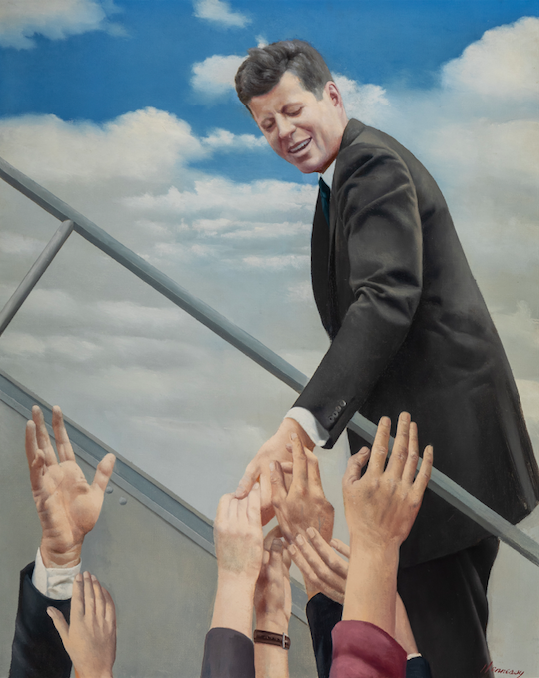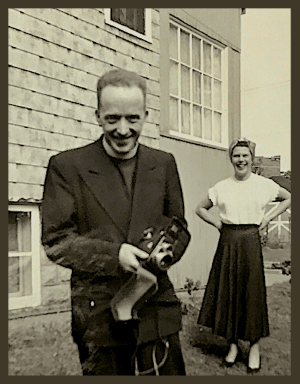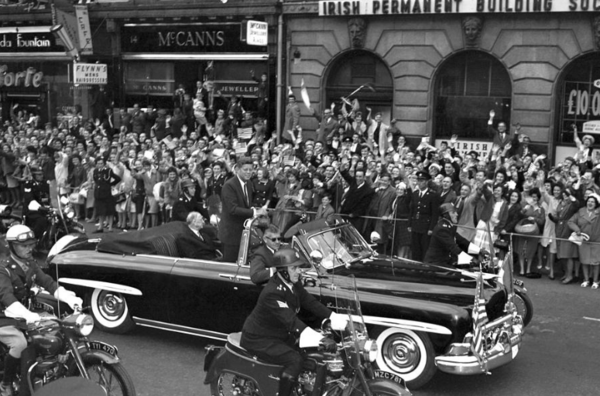Farewell to Ireland

Patrick Hennessy
Oil on canvas: 49”x 39”
The O’Brien Collection
Patrick Hennessy, RHA ( 1915-1980), was one of Ireland’s most successful post-war realist painters. A prolific artist, he created traditional portraits, landscapes, equines studies and still-lifes, but he also created works unlike anything being made in Ireland at the time. Fusing realism with a Surrealist subjectivity learned in Paris, he painted human figures isolated in the landscape and African men that puzzled Irish critics who branded him ‘something of an outsider.’
Biography: In the Irish Museum of Modern Art (Dublin) magazine, read this article on visitors' reaction to the Patrick Hennessy exhibit:
"Visitors to Patrick Hennessy's exhibit discover how unusual he was"
The Painting
It is difficult to overstate the positive impact of JFK’s official visit to Ireland in 1963. He was one of our own. He addressed our parliament as effortlessly as he took tea and cake with his relatives in New Ross. He was Catholic and young, handsome and charismatic, more movie star than statesman. And we loved him. In one short trip he honored his heritage at home while saluting our diaspora abroad. He made us proud that our descendants and our living relatives made and were making America a great nation. He departed like countless souls before, but not before promising to return in the springtime. Again, the narrative was new. Farewell now did not mean goodbye.
Although Patrick Hennessy used a stock press photograph he judiciously cropped the image, making for a more impactful composition. He placed the President firmly to one side removing any distracting background detail. He straightened and slightly elongated his back, as JFK’s posture was at times compromised by chronic pain, thereby making him appear stronger and more imposing. Finally, he edited the outstretched arms and hands into a clearer arrangement in the lower third of the painting. The more vertical dimensions of Hennessy’s canvas and his clever fine tuning of the composition of the original photograph made the image more immediate and underscored the adulation the President was held in on every part of his visit. This final moment at Shannon, our gateway to the States, shows an almost deified persona ascending Mount Olympus rather than the stairs to Air Force One.
There is a second painting by Hennessy in the departure lounge at Shannon Airport which seems to be a companion piece to Farewell to Ireland. It shows President Kennedy from the front waving to people out of shot. Behind him stands a group of Irish dignitaries, including An Taoiseach, Sean Lemass. Although more conventional in composition, it has a Hennessy hallmark of a dramatically foregrounded central figure with secondary figures significantly smaller in scale. Hennessy was an inspired choice for these commemorative canvasses. He was unmatched for his remarkable technical prowess as a painter. His depictions of still lifes, landscapes, people, and animals were marked by their astonishing verisimilitude. His pictures were characterized by convincing surfaces, close tonal harmonies, lush color schemes, and sophisticated compositions. No artist likes to work from a secondary source alone, but in this case Hennessy had only the press photographs from the day from which to work. Notwithstanding, he made them his own and transformed black and white reportage into an iconic painted moment.
— James Hanley, in the catalog to the exhibit Who Do We Say We Are? Irish Art 1922 | 2022, held at Notre Dame's Snite Museum of Art, Spring 2022, and in which Farewell to Ireland was displayed.
Read this article in The Irish Times (15 June 2013) on the origin of the painting's commission.
And this short commentary on JFK’s legacy, by Robert Schmuhl, Walter H. Annenberg-Edmund P. Joyce Chair Emeritus in American Studies and Journalism
The seven outstretched hands tell as much of a story as the “for me?”
expression on the face of the departing visitor. As he ascends the steps to his
waiting aircraft, the people (though unseen) reach out to offer a final wave or
receive a last grasp of his hand.
Patrick Hennessy’s “Farewell to Ireland” portrays triumph before tragedy.
John Kennedy, the 35 th president of the United States, is leaving his ancestral
homeland after four momentous days in 1963. The sojourn, according to
contemporary and historical accounts, deeply affected the 46-year-old. He departed
feeling more Irish than when he arrived, more at one with his heritage.
For his painting, Hennessy, a Cork-born artist and member of the Royal
Hibernian Academy, took a picture taken by a photojournalist at the Shannon
Airport as inspiration for a realistic work with enduring meaning. JFK is climbing
stairs for a flight into fluffy clouds on what seems a sunny day, but he appears
elated as he reaches down to people excited at his leave-taking.
Ryan Tubridy’s JFK In Ireland: Four Days that Changed a President (2010)
is an engrossing, illustrated chronicle of this presidential visit. Tubridy reminds
readers that Kennedy arrived in Dublin on June 26, 1963, the same day he
delivered one of the most significant foreign policy addresses during the Cold War.
With the Berlin wall nearby, the American leader announced his solidarity with
believers in Western freedom over Communist totalitarianism by affirming, “Ich
bin ein Berliner.” The Irish American asserted he was a Berliner, too.
While the words of his speech reverberated throughout the world, Kennedy
took personal delight in the chance to explore his roots. Cheering for him
thundered across the island wherever he went, and he was moved. In Limerick on
June 29 shortly before he left, he went so far as to say: “This is not the land of my
birth but it is the land for which I hold the greatest affection, and I certainly will
come back in the springtime.”
That springtime never came. The poignancy of Hennessy’s painting is that it
evokes an exuberant moment 146 days before an assassin brought an end to the
president’s life and to a season of hope. In a way, this particular work of art
foreshadows history. It’s a “Farewell to Ireland” while also being a portrait of
people symbolically wanting to connect with a leader they admire. But on that
fateful Friday, November 22, 1963, John Kennedy was gone. The people with
outstretched hands, and millions of others, suffered the heartbreak of a grief that
still endures nearly six decades later.
____________
From O'Brien Family Collection Curator Marty Fahey:
Please scroll down to the bottom of the page to watch the actual footage. It is interesting to note that the film was created by Fr. Gerry Smyth, a Cavan-born Columban Father who was stationed in Chicago for many years in the 1960s and a family friend.

POETIC / HISTORICAL CONTEMPLATION:
When JFK died, the CIA sent Johnson his favorite poem as a tribute (and a warning)
From September 18, 2015 (Internet posting on medium.com )
Every morning, presidents wake up to what is known as the President’s Daily Brief — a rundown of CIA intelligence from across the globe, detailing the current standing of geopolitical situations that the Commander in Chief should be privy to.
These first of these memos was issued under President John F. Kennedy, on June 17, 1961. On the morning of his assassination on November 22, 1963, he received intelligence detailing how a Japanese election the day before “did not change the general balance between conservatives and socialists,” and another note about a planned student trip to Cuba, to name a few items.
Later in the day, though, after Lee Harvey Oswald shot and killed the President, the CIA issued a second Daily Brief.
It contained a mere few sentences:
For this day, the Checklist Staff can find no words more fitting than a verse quoted by the President to a group of newspapermen the day he learned of the presence of Soviet missiles in Cuba:
Bullfight critics ranked in rows
Crowd the enormous plaza full;
But only one is there who knows
And he’s the man who fights the bull.
-Domingo Ortega
This tribute was compiled and sent out by an unnamed CIA employee. The communication was declassified by the CIA just this week, along with over 19,000 other documents from the 1960s. Kennedy was known to always keep a copy of the lines in his wallet.
The four lines, written by Spanish bullfighter Domingo Ortega, and translated by Robert Graves, are haunting and tangled in complexity. Stepping into his new role as President, it would have been the first CIA briefing Lyndon B. Johnson received. A wake-up call if there ever was one. Inside the ring, the bullfighter must focus. There, the words of critics can’t reach him. He is the center of attention, of all speculation. But he is alone.
He is always alone.
MUSICAL REFLECTION:
Track 3: Omós do na Mairbh ( Lament for the Dead) (comp. Michael Rooney)
From the wonderful new CD, Tobar an Cheoil, with June Mc Cormack and Michael Rooney
https://www.draiochtmusic.com/store/pre-order-tobar-an-cheoil-1
